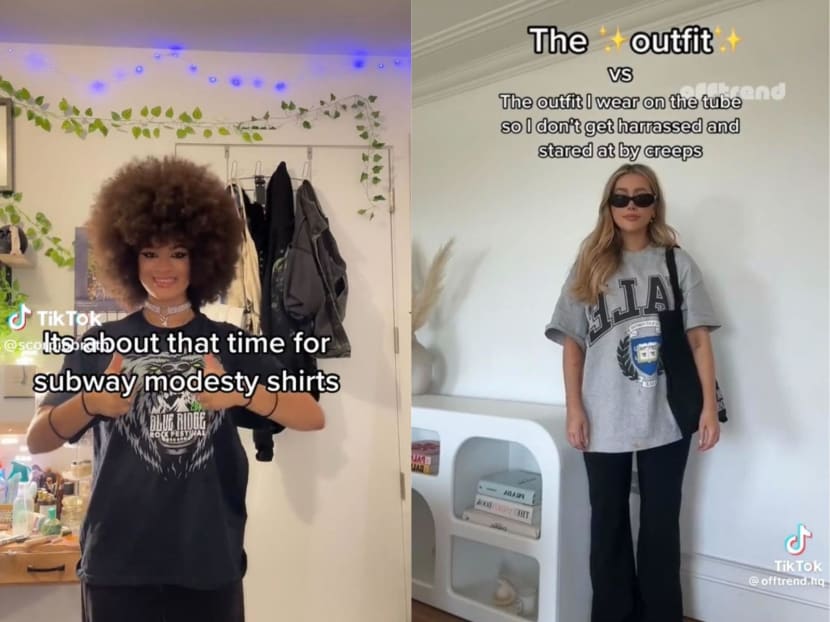Wearing a ‘subway shirt’ to avoid harassment on public transport: Singapore women weigh in on this US trend
Garnering millions of views on TikTok, the loose garment known as the 'subway shirt' is what women in the US and the UK wear over their outfits to protect themselves against unwanted stares and catcalling while travelling on public transportation. Singaporean women share their perspectives with CNA Women.

Women in the US, particularly in New York City, turn to 'subway shirts' as a shield from being disturbed or catcalled. (Screen grabs: TikTok/scorpiobroth/offtrend.hq)
Have you heard of the "subway shirt" trend? No, it has nothing to do with fast food and sandwiches but an unlikely mix of fashion, public transportation in the United States – and an ongoing discussion about women's safety.
Taking its name from the public trains of the US, the "subway shirt" refers to oversized clothing that women wear in public areas to avoid sexual harassment.
Defined by the Association of Women for Action and Research in Singapore as "offensive, unwanted and unwelcome behaviour of a sexual nature", harassment includes actions such as catcalling, leering and making obscene gestures.
With the US and the UK in the thick of the summer season, the trend has exploded there, with the hashtag #SubwayShirt making its rounds on TikTok. The videos feature women wearing an additional shirt over their chosen outfits while riding the train as a safety measure, and removing that extra shirt when they feel more secure or in a safer location.
Many of these videos have garnered millions of views, with women expressing support in the comments section.
But what does that have to do with Singapore? CNA Women recently asked some women here, a country known for both its humidity, hot weather and relative safety, what they thought about the trend and whether the fashion trend and the issues it raises are relevant here.
TO WEAR OR NOT TO WEAR?
For hospital manager Vanessa Lim, an extra layer of clothing when you’re out and about in hot weather can be a bit of an inconvenience.
“I want to dress (up in) what makes me feel most comfortable and wearing a whole other layer in this weather won’t do it for me,” said the 33-year-old, who added that commuters here generally keep to themselves.
“I don’t think many people really look or pay attention to one another in Singapore. Perhaps I’m just oblivious to other people if they look, but I wouldn’t take up this trend."

Meanwhile, healthcare executive Peh Min Hui has taken to occasionally wearing her own version of the subway shirt.
“Wearing more revealing clothes in places that are more conservative like Singapore would naturally cause people to stare,” the 26-year-old said. “Some people are okay with the stares, but I'm not so I would wear my version of a subway shirt when I'm on the way to the gym in my workout outfit.”
WHAT MAKES YOU MORE COMFORTABLE?
Many of the women we talked to said the decision to consider wearing subway shirts boils down to their comfort levels – including feeling safe – in different scenarios.
“It could be about wearing differently when on familiar grounds versus being surrounded by people I don’t know,” said Esther Poon, a 25-year-old bank analyst. “Maybe I’m just comfortable wearing shorts around my friends but not (around) a random older man."
Nursarah Safari said that as wearing loose clothing may make women feel safer while taking public transportation, the trend makes sense.
"As someone who dresses modestly, I empathise,” said the 23-year-old teacher. “I totally understand the rationale behind seeking refuge in modest clothing, especially if it means the women feel safer and more comfortable. It’s very applicable in Singapore, too.”
She added: “I think the trend shows us that there are ways for women to 'attract less attention' and safeguard themselves in public – even when they shouldn't have to – and that dressing modestly is one of them.”
LITERAL PROTECTION AGAINST HARASSMENT
At the same time, it’s not just about feeling comfortable and safe but literally being safe too – including from being photographed without their consent.
“With today’s technology, harassers can easily and stealthily take pictures of women without being noticed, it’s very disturbing,” said Poon.

“I don’t think the clothes will totally protect women from harassment, because it’s less about what the woman is wearing and more about the harasser’s actions,” she said. “But it’s still a way to protect themselves from having their pictures of their bodies shared on gross groups like SG Nasi Lemak.”
The deceivingly innocent title refers to the 7,000-member strong Telegram chat group that distributed obscene content of women, most of which was shared without the subject's consent.
SUBWAY SHIRTS AREN’T THE ANSWER
But while the trend is going strong, the women we talked to also questioned why it’s even a thing in the first place.
Zahrah Aljufri, 28, a content strategist said: “I do believe in choosing to do whatever is necessary to feel safe and at ease when we’re outside, but I do not agree that women’s appearance and outfits are the problem.”
While it’s “definitely a means for women to feel safer”, it points to a “bigger and more pressing problem,” she said.
“In terms of the utility of a subway shirt as prevention from harassment, molestation and sexual assault, predators are going to be predators no matter what we wear,” Peh added. “A subway shirt shouldn't be a prerequisite for women to be safe in public.”
CNA Women is a section on CNA Lifestyle that seeks to inform, empower and inspire the modern woman. If you have women-related news, issues and ideas to share with us, email CNAWomen [at] mediacorp.com.sg (CNAWomen[at]mediacorp[dot]com[dot]sg).







